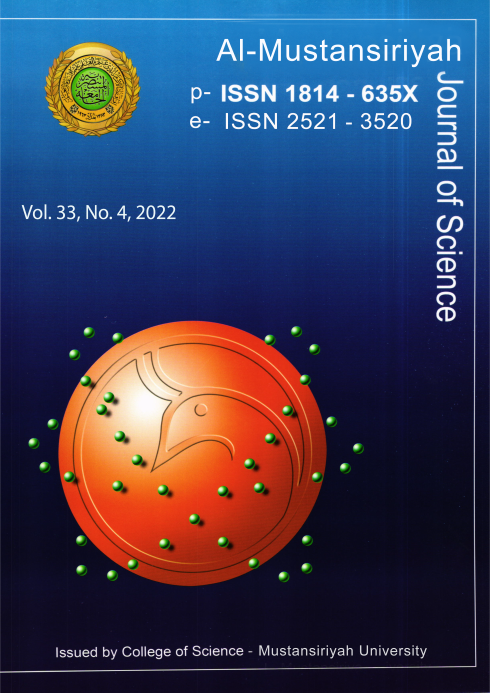Tuning TiO2 Porosity of Multilayered Photoanode Towards Enhanced Performance of Dye Sensitized Solar Cell
DOI:
https://doi.org/10.23851/mjs.v33i4.1185Keywords:
TiO2 nanoparticles, ball milling, quantum confinement, DSSC.Abstract
In this paper, we prepared Titanium Dioxide (TiO2) based dye sensitized solar cells (DSSC). Downscaling of commercial TiO2 powder have been achieved by systematic ball milling carried out using home-made ball milling device. Thin films were prepared and samples were characterized by XRD, SEM, UV-Vis and I-V. The main objective of this work is to prepare TiO2 based (DSSC) using N3 dye and study the effect of the TiO2 grain size inside the photoanode layer on the efficiency of the solar cell. UV-vis study of nanometer sized TiO2 particles showed that the energy gab has shifted towards the lower wavelength in electromagnetic spectrum (blue shift), and then optical band gap is an indirect and allowed transition. Energy gap calculations of related grain size of showed quantum confinement effect. A sophisticated strategy for TiO2 films consisting of tailoring monolayer, bilayer and trilayer of mixed multisized nanoparticles were adopted and investigated as DSSC electrodes. Our results showed that the dye sensitized solar cells can be substantially altered due to the designs and the particle size distributions of the TiO2 photoelectrode. The maximum efficiency of 0.5% was reached by TiO2 photoelectrode designed as a trilayer with a particles of wide size distribution from about 12 to 340 nm in the middle layer. The approach of light scattering in submicrometer‐sized TiO2 nanoparticles aggregates was adopted in order to interpret the enhancement of our DSSC efficiency over extending the length transported by electromagnetic wave hence to promote the light acquiring efficiency of photoelectrode thin film. The relatively larger particle sizes afford the TiO2 films with both better packing and an increased capability for scattering of the incident electromagnetic wave, and hence improves our DSSC efficiency.
Downloads
References
O'Regan B, Gratzel M (1991) A low-cost, high-efficiency solar cell based on dye-sensitized colloidal TiO2 films. Nature 353:737-740.
S.Mathew, A. Yella, P. Gao et al., "Dye-sensitized solar cells with 13% efficiency achieved through the molecular engineering of porphyrin sensitizers," Nature Chemistry, vol. 6, no. 3, pp. 242- 247, 2014.
Sayak Bhattacharya & Sajeev John "Beyond 30% Conversion Efciency in Silicon Solar Cells: A Numerical Demonstration" Natureresearch Scientific Reports 9:12482 (2019).
F. Sauvage, D. Chen, P. Comte, F. Huang, L. P Heiniger., Y. B. Cheng, R. A. Caruso and M. Gratzel, ACS Nano, 2010, 4(8), 4420-4425.
T. K. Yun, S. S. Park, D. Kim, Y. K. Hwang, S. Huh, J. Y. Bae and Y. S. Won, J. Power Sources, 2011, 196(7),3678-3682.
S. Chehreh Chelgani , M. Parian, P. Semsari Parapari, Y. Ghorbani, J. Rosenkranz "A comparative study on the effects of dry and wet grinding on mineral flotation separation-a review" Elsevier Mater Res. Technol 8(5) 5004-5011 (2019).
Chelgani, S. C., Parian, M., Parapari, P. S., Ghorbani, Y., & Rosenkranz, J. A comparative study on the effects of dry and wet grinding on mineral flotation separation - a review. Integrative Medicine Research, 8(5), 5004-5011 (2019).
Mill, E., & Ogonowski, Z. (2018). Comparison of Wet and Dry Grinding in, 1-19.
Valenta, Jan Mirabella, Salvo SN - 978-981-4463-63-8 - Nanotechnology and Photovoltaic Devices: Light Energy Harvesting with Group IV Nanostructures (2015).
Munir H. Nayfeh Fundamentals and Applications of Nano Silicon in Plasmonics and Fullerines: Current and Future Trends (Micro and Nano Technologies) Elsevier; 1st edition (2018).
Litter M. Heterogeneous photocatalysis transition metal ions in photocatalytic systems. Appl Catal B: Environ 1999; 23: 89-114.
T. Edvinsson, Optical quantum confinement and photocatalytic properties in two-, one- and zero-dimensional nanostructures, Royal Society (2018)
N. G. Park, J. Van De Lagemaat, and A. J. Frank, "Comparison of dye-sensitized rutile-and anatase-based TiO solar cells," Journal of Physical Chemistry, vol. 104, no. 38, pp. 8989-8994, 2000.
Janczarek, M., & Kowalska, E. "On the Origin of Enhanced Photocatalytic Activity of Copper ‐ Modified Titania in the Oxidative Reaction Systems". JourCatalysts, 7, 317; (2017).
Liu, Y., Lu, Y., Zeng, Y., Liao, C., Chung, J., & Wei, T. (2011)." Nanostructured Mesoporous Titanium Dioxide Thin Film Prepared by Sol-Gel Method for Dye-Sensitized Solar Cell", International Journal of Photoenergy Volume 2011, Article ID 619069 (2011).
K. Tanaka, M. F. V. Capule, and T. Hisanaga, "E ffect of crystallinity of TiO 2 on its photocatalytic action," Chemical Physics Letters, vol. 187, no. 1-2, pp. 73-76, 1991.
Downloads
Key Dates
Published
Issue
Section
License
Copyright (c) 2022 Al-Mustansiriyah Journal of Science

This work is licensed under a Creative Commons Attribution-NonCommercial 4.0 International License.
(Starting May 5, 2024) Authors retain copyright and grant the journal right of first publication with the work simultaneously licensed under a Creative Commons Attribution (CC-BY) 4.0 License that allows others to share the work with an acknowledgement of the work’s authorship and initial publication in this journal.






















